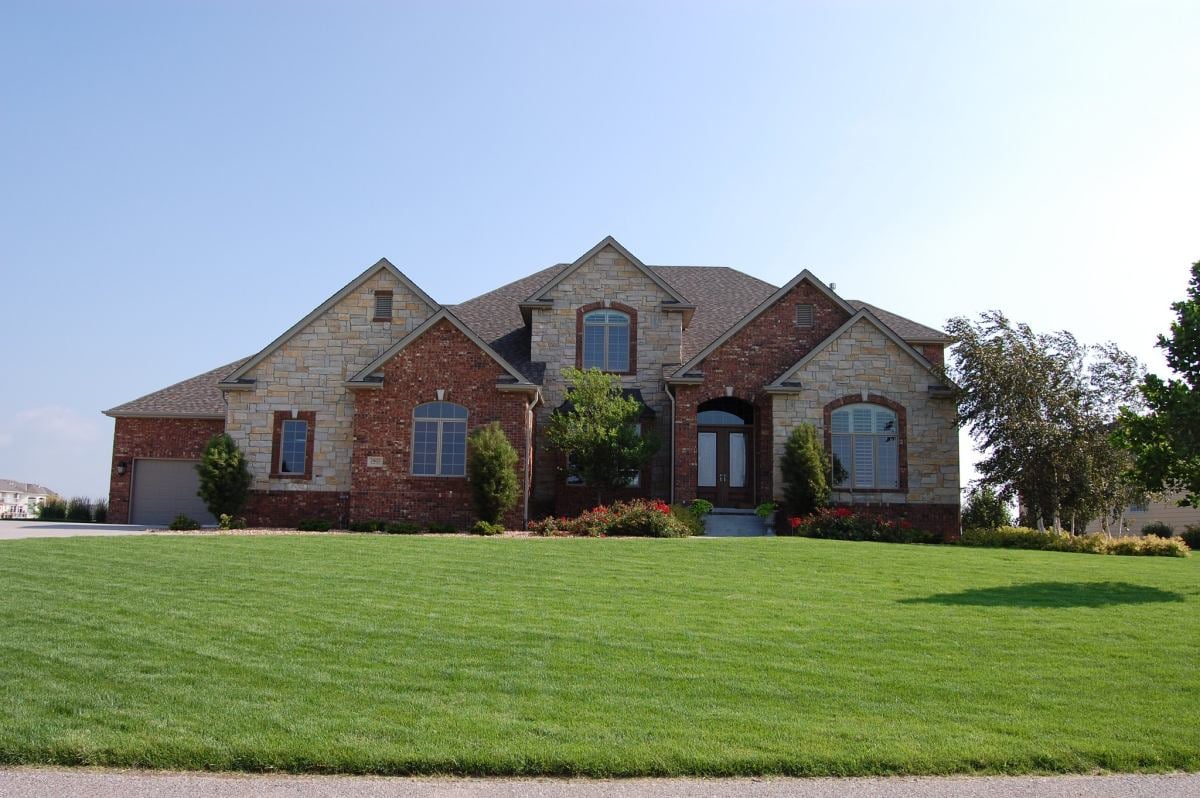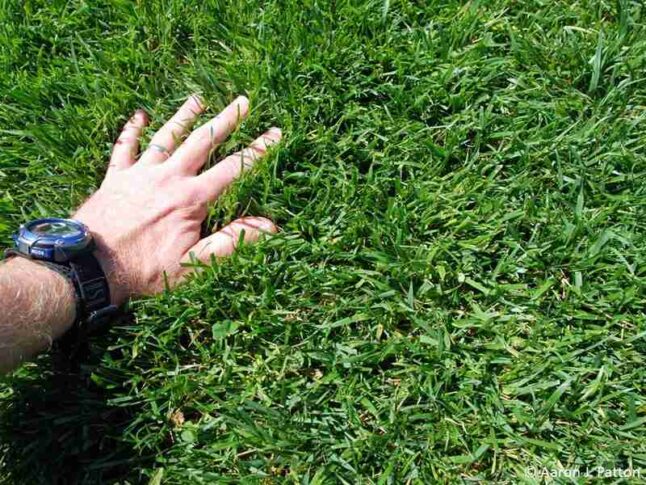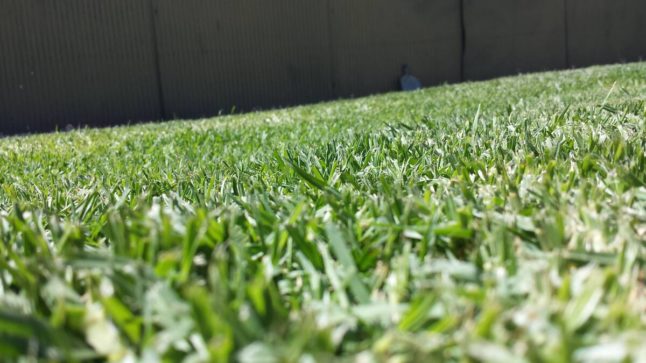
Many homeowners dream of a lush lawn, and Omahans are no exception. The first step toward getting a green lawn in the Midwest is picking the right type of turfgrass. You need one that can survive The Big O’s conditions, which include drought, hot summers, and harsh winters. Here are the three best grass types for Omaha lawns:
1. Tall Fescue (Festuca arundinacea)

Hardy and coarse, tall fescue is the turfgrass species that’s best adapted to Eastern Nebraska. This cool-season grass can survive in various soil conditions, although it thrives in well-draining, fertile clay soils.
Pros: It can also withstand a fair amount of wear and tear, disease, heat, drought, and mild neglect. Tall fescue can survive in these conditions because of its root system, which grows deep enough to support the grass in poor growing conditions.
Cons: However, tall fescue grass also has its downsides. While it boasts a decent drought tolerance, extended drought will turn it fully brown and send it into dormancy. Dormancy is devastating for tall fescue, as it can’t recover as fast as other grass types.
Aside from that, tall fescue lawns thin out during extreme cold, and they don’t respond well to overfertilization. Lastly, although it’s quite disease-tolerant, tall fescue is susceptible to brown patch.
Despite its flaws, tall fescue is still a great turfgrass choice with lower maintenance requirements than other cool-season grasses. If you want to seed your lawn with this turfgrass, the University of Nebraska–Lincoln Institute of Agriculture and Natural Resources (UNL-IANR) recommends avoiding the ‘Kentucky 31’ (‘KY 31’) cultivar.
- Classification: Cool-season grass
- Spreads Through: Weakly through rhizomes, grows in bunches
- Tolerances
- Shade: Moderate
- Drought: Moderate to high, but extended drought will really hurt it
- Foot Traffic: Moderate
- Diseases and Pests: Moderate
- Maintenance Needs: Needs frequent mowing, especially in the spring
- Mowing Height: 2 inches, but only mow when the grass reaches 3 inches tall
- Soil pH: 5.5 to 6.5
- Soil Type: Tolerates a variety of soil conditions but does best in well-draining fertile clay soils
Grass Seed Options:
– Triple-Play Tall Fescue Grass Seed Blend (5000 sq ft)
– Eretz Kentucky 31 K31 Tall Fescue Grass Seed (choose your size)
– Pennington The Rebels Tall Fescue Grass Seed Mix (7 lb.)
2. Buffalograss (Bouteloua dactyloides)

Despite the harsh winter temperatures, Omahans aren’t restricted to just cool-season grass species. Spanning as far north as Canada, buffalograss is the most cold-tolerant warm-season grass, largely thanks to its strong winter dormancy response. This native grass goes dormant earlier than other species and wakes up from dormancy quite late.
While the long dormant period lets buffalograss survive through Omaha’s cold winters, it’s a double-edged sword. Because it restarts growing much later, cool-season grasses and weeds can take over a buffalograss lawn much easier. This dormancy also means that your lawn will only be green from May to October, unlike lawns with cool-season grasses.
Buffalograss is an excellent choice for homeowners that want a very low-maintenance lawn. This fine grass forms a dense sod with a deep root system that doesn’t need much mowing, watering, or fertilizing. It also loves the full sun.
- Classification: Warm-season grass
- Spreads Through: Stolons
- Tolerances
- Shade: Low
- Drought: High
- Foot Traffic: Low
- Diseases and Pests: Good, but watch out for chinch bugs
- Maintenance Needs: Doesn’t need a lot of water or fertilizer and only needs to be mowed about once a month; watch out for weeds
- Mowing Height: 2 to 3 inches
- Soil pH: 6.5 to 7.5
- Soil Type: Prefers native clay soils. Don’t plant in sandy soil.
Grass Seed Options:
– Everwilde Farms Buffalograss Seeds (1 lb. of seeds)
– Scotts Pursue Buffalograss with Natural Seed (1 lb. of seeds)
– Outsidepride Perennial Buffalo Grass Seed (2 lb. of seeds)
3. Kentucky Bluegrass (Poa pratensis)

With its dark green to blueish hues, it’s no wonder that many American homeowners love Kentucky bluegrass on their lawns. This medium-textured turf can handle foot traffic well and is one of the most cold-tolerant cool-season grasses. It also doesn’t mind a little drought, although it browns when exposed to too much heat.
It’s better to underwater Kentucky bluegrass than overwater it. While a water shortage will thin out a Kentucky bluegrass lawn, it’s much preferable to the thatch build-up and disease that overwatering invites. That’s not ideal, especially when this turfgrass is already susceptible to many diseases, like summer patch, and common lawn pests, like white grubs.
Needing about 3 to 4 hours of lawn care per week, Kentucky bluegrass is more high-maintenance than buffalograss and tall fescue. If you decide to grow this turf species, the UNL-IANR recommends staying away from the ‘Kenblue’ cultivar.
- Classification: Cool-season grass
- Spreads Through: Rhizomes
- Tolerances
- Shade: Low, but some varieties have a slightly higher shade tolerance
- Drought: Moderate
- Foot Traffic: Moderate
- Diseases and Pests: Low; prone to lawn diseases, preyed on by white grubs
- Maintenance Needs: Needs frequent mowing and tends to produce a lot of thatch. It also needs more fertilizer than the other grasses on this list.
- Mowing Height: 2.5 to 3.5 inches
- Soil pH: 6 to 7.5
- Soil Type: Prefers well-drained, heavy, and fertile soils
Grass Seed Options:
– Jonathan Green (11970) Blue Panther Kentucky Bluegrass Grass Seed (3 lbs.)
– SeedRanch Midnight Kentucky Bluegrass Seed (5 lbs.)
– Jacklin Seed – Biltmore Blue Blend – 100% Kentucky Bluegrass (5 lbs.)
FAQ About Grass Types for Omaha
While some might recommend annual ryegrass to quickly patch up a thinning lawn or to help your primary grass as it establishes, the UNL-IANR doesn’t recommend it, as it only lasts for one growing season. It’s also quite difficult to get rid of, as it can reseed over multiple years, contaminating your lawn’s green color with its light yellow.
If you want a “nurse” grass, you should choose perennial ryegrass instead. However, this grass is susceptible to disease. The UNL-IANR suggests using about 10-15% perennial ryegrass in your seed mix if you want to use it; this is enough for ground cover but not enough to compete with the primary turf when it emerges.
Many of Omaha’s numerous golf courses use bentgrass species. Bentgrasses are more prone to diseases and require a lot of maintenance.
The time to seed depends on what type of grass you want to grow on your Omaha lawn. Seeding or overseeding cool-season grasses should be part of your fall lawn care schedule. They can be seeded as early as August 15.
The UNL recommends seeding a tall fescue lawn by September 15, while a Kentucky bluegrass lawn can wait until October 15. If you want to overseed Kentucky bluegrass, you should do it between August 15 to September 1.
If you’re establishing a buffalograss lawn, then you should seed your lawn in late spring but no later than August 15th.
Keep Your Omaha Lawn Healthy and Green
Picking the right grass is only the first step toward a beautiful lawn. You can get the rest of the way there through good lawn management, including proper mowing, fertilization, and watering. Some lawns require a lot of maintenance: Kentucky bluegrass needs about three to four hours of care weekly! Instead of doing that yourself, why not hire a professional lawn company to help you out? Contact an Omaha lawn care professional today.
LawnStarter participates in the Amazon Services LLC Associates Program, an affiliate advertising program. LawnStarter earns revenue from products promoted in this article.
Main Photo Credit: Ryan Renner / Flickr / CC BY 2.0